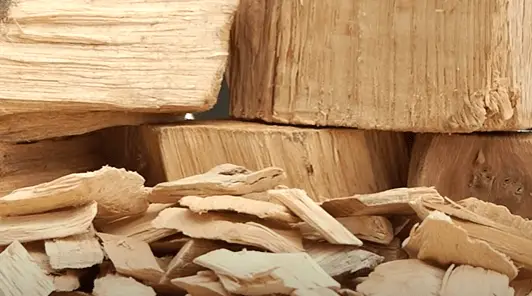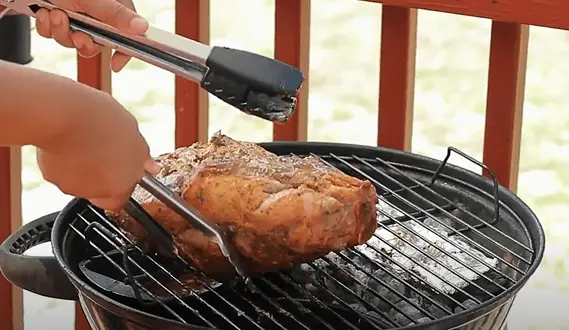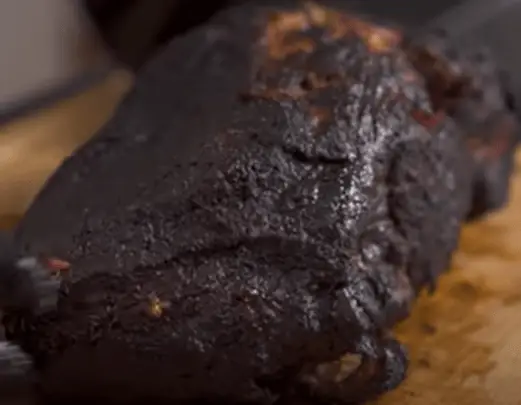Hey there, fellow meat lovers! If you’re anything like me, there’s nothing more satisfying than the smell and taste of perfectly smoked pork.
But did you know that the type of wood you use can make all the difference in achieving that mouthwatering flavor?
As someone who has experimented with different wood types, I’m excited to share my personal experience and knowledge on the best wood for smoking pork.
Trust me, with the right wood selection, you’ll elevate your pork game to a whole new level…!

- Best Wood for Smoking Pork
- 1. Applewood
- 2. Hickory
- 3. Cherrywood
- 4. Maple
- 5. Pecan
- # What should I consider before purchasing wood for smoking Pork?
- # Tips for Smoking Pork with Wood.
- # Safety considerations When Smoking Pork.
- # What are the steps to follow for smoking Pork effectively?
- # Frequently Asked Questions
Recommended Reading:
– Best wood for smoking fish
– Best wood for smoking brisket
– Best wood for smoked salmon
– Best wood for smoking turkey
– Best wood chips for smoking
– Best wood for smoking meat
– Top wood to smoke chicken
– Top wood pellets
– Top wood for smoking lamb
– Top wood for smoking beef
Best Wood for Smoking Pork
1. Applewood
Apple wood adds a sweet and fruity taste to pork, resulting in a gentle and slightly tangy flavor.
2. Hickory
Hickory wood provides a strong and robust smoky flavor that enhances the natural richness of pork.
3. Cherrywood
Cherrywood adds a delicate and sweet smoke flavor to pork, accentuating its natural sweetness and providing a hint of fruitiness.
4. Maple
Maple wood imparts a gentle and well-balanced smoke flavor to pork, offering a subtle sweetness that enhances the overall taste.
5. Pecan
Pecan wood imparts a mellow and nutty smoke flavor to pork, enhancing its taste with a distinctive and slightly sweet touch.
# Comparison Table:
| Wood Type | Flavor Profile | Suitable Pork Cuts | Smoke Intensity |
| Apple | Sweet, fruity | Ribs, loin, tenderloin | Mild |
| Hickory | Bold, rich | Shoulder, ribs, bacon | Strong |
| Cherry | Subtle, slightly sweet | Ribs, pork loin, tenderloin | Mild |
| Maple | Mild, balanced | Ham, pork chops | Moderate |
| Pecan | Mellow, nutty | Pork shoulder, ribs, pork belly | Moderate |
# What should I consider before purchasing wood for smoking Pork?
Before purchasing wood for smoking pork, there are several factors to consider:
- Flavor Profile: Select a wood for smoking that aligns with your desired flavor profile, as different wood types provide varying levels of taste intensity.
- Intensity: Choose a wood for smoking based on the desired intensity of smokiness, as some woods produce a stronger smoke flavor than others.
- Sweetness: Choose fruitwoods such as apple or cherry for a gentle touch of sweetness in your smoked pork, allowing you to decide if you desire that subtle flavor addition.
- Compatibility: Select a wood that is specifically suitable for smoking pork to enhance the flavor. Avoid using woods that are more appropriate for beef, such as mesquite, and opt for options like apple or hickory that pair well with pork.
- Availability: Choose readily available woods that are easily accessible in your region when selecting the best wood for smoking pork.
- Personal Preference: Consider your personal taste and past experiences with different wood types when selecting the best wood for smoking pork. Choose a wood that suits your preferences and cooking style.
- Cooking Time: Select a wood for smoking pork based on its burning rate and heat output, ensuring it aligns with the desired cooking time for the meat.
- Versatility: Choose versatile woods like oak that complement a variety of meats, allowing you to smoke different types of protein with one wood selection.
- Quality: Prioritize the use of high-quality, chemical-free wood for smoking pork. Select seasoned and dry wood that is safe and suitable for smoking purposes.
- Budget: Keep in mind the cost and availability of wood when selecting the type to smoke pork with. Choose a wood option that is affordable and easily accessible within your budget.
# Tips for Smoking Pork with Wood.
- Choose the right wood: Choose fruitwoods such as apple, cherry, or peach to complement the flavor of pork with their subtle and sweet smoky taste.
- Pre-soak wood chips: If using wood chips, soak wood chips in water for 30 minutes before smoking to produce a steady smoke and slow down the burn rate.
- Control the temperature: Maintain a steady temperature between 225-250°F (107-121°C) during smoking to achieve even cooking and preserve the pork’s moisture.
- Use a meat thermometer: A reliable meat thermometer is essential for monitoring the pork’s internal temperature, ensuring it is cooked to perfection and avoiding undercooking or overcooking.
- Apply a dry rub or marinade: Before smoking, apply a dry rub or marinade to the pork to enhance its flavor. Let it marinate for a few hours or overnight in the refrigerator for the flavors to penetrate.
- Don’t over smoke: Use wood sparingly to prevent an overpowering smoky taste in the pork, ensuring a balanced and mild flavor that allows the natural pork flavors to be prominent.
- Maintain proper airflow: Maintain optimal airflow in your smoker by adjusting vents or dampers to achieve consistent temperature and even smoke distribution.
- Allow for resting time: Give your smoked pork a resting period after cooking to allow the juices to redistribute and the flavors to meld together, resulting in tender and flavorful meat.
- Experiment with wood combinations: Get creative with your wood choices when smoking pork. Try mixing different types like apple and hickory or cherry and oak to create unique and complex flavor profiles for your smoked pork.
- Practice patience: Be patient when smoking pork, as it requires slow and low cooking to ensure thorough cooking and delicious smoky flavor. Don’t rush the process.
# Safety considerations When Smoking Pork.
Here are some important safety considerations to keep in mind when smoking pork:
1. Use a safe smoking environment: Smoke pork in a well-ventilated outdoor space to avoid the buildup of smoke and carbon monoxide.
2. Practice proper food handling and storage: Take necessary precautions for the safe handling and storage of raw pork to prevent contamination, following proper food safety guidelines.
3. Cook pork to the correct temperature: Ensure pork safety by using a meat thermometer to reach the recommended internal temperature of 145°F (63°C) for whole cuts and 160°F (71°C) for ground pork.
4. Monitor smoke production: Prevent a bitter taste and potential health risks by avoiding excessive smoke. Maintain a moderate smoke level by adjusting the amount of wood or chips used.
5. Practice fire safety: Keep a fire extinguisher nearby, closely monitor the smoking process, and follow safety instructions for your specific equipment to prevent accidents and flare-ups.

# What are the steps to follow for smoking Pork effectively?

To smoke pork effectively, follow these steps:
1. Preparing the Pork
Trim excess fat and apply a dry rub or marinade for flavor.
2. Preparing the Smoker
Clean and preheat the smoker to the desired temperature (usually 225-250°F or 107-121°C).
3. Choosing the Wood
Select a suitable wood type (such as apple, hickory, or cherry) that complements the pork’s flavor.
4. Controlling the Smoke
Add wood chips or chunks to the smoker to generate smoke. Maintain a moderate smoke level to avoid bitterness.
5. Placing the Pork
Place the pork on the smoker’s grates, fat side up, and close the lid.
6. Monitoring the Temperature
Use a meat thermometer to track the internal temperature of the pork. Aim for 145°F (63°C) for whole cuts and 160°F (71°C) for ground pork.
7. Maintaining the Heat
Maintain a consistent temperature throughout the smoking process by adjusting vents or dampers as needed.
8. Timing and Patience
Smoking pork is a slow and low process. Allow enough time for the pork to cook thoroughly and develop a smoky flavor.
9. Resting the Pork
Once cooked, let the pork rest for a few minutes to allow the juices to redistribute and the flavors to settle.
10. Slicing and Serving
Slice the pork against the grain and serve it hot. Enjoy the delicious smoky flavors of your perfectly smoked pork.
# Frequently Asked Questions
# What is the best wood for smoking pork?
Different woods offer unique flavors, but popular options for smoking pork include apple, cherry, hickory, maple, and pecan.
# Can I use any type of wood for smoking pork?
Select wood varieties that enhance the flavor of pork, such as fruitwoods and hardwoods, for optimal smoking results.
# What wood flavors pair well with pork?
Apple and cherry add sweetness, hickory brings boldness, and maple and pecan offer a mild and balanced flavor to smoked pork.
# Does the type of wood affect the cooking time of pork?
Wood type has a minimal effect on cooking time for smoking; pork cut and size are the primary factors determining the cooking duration.
# How does the choice of wood impact the flavor of smoked pork?
Wood type impacts pork flavor; each kind has its own taste profile, from sweet to smoky, that adds distinct characteristics to the final dish.
# Is it necessary to soak wood chips before using them for smoking pork?
No, soaking wood chips is optional. So it is not necessary to soak wood chips before using them for smoking pork.
Soaking wood chips can slow the burn rate, while dry chips release smoke faster.
# Can I mix different wood types when smoking pork?
Yes, you can mix different wood types when smoking pork. Try mixing apple with hickory or cherry with maple to create unique flavors for your smoked pork.
# Are there any woods to avoid when smoking pork?
Avoid using softwoods such as pine or cedar for smoking pork as they can release resin and cause unpleasant flavors. Opt for hardwoods and fruitwoods for better results.
# How should I store wood for smoking pork?
Store your wood in a dry and well-ventilated area to prevent mold or moisture buildup. Keep it protected from the elements to maintain its quality for smoking.
# Can I reuse wood for smoking pork?
Consider the condition of the wood before reusing it for smoking pork, ensuring it’s not overly charred or ashed. Fresh wood is preferred for the best flavor results.
# Conclusion
In conclusion, the flavor of your smoked pork is significantly influenced by the wood you choose.
It is possible to customize and improve the flavor experience by experimenting with various types of wood.
Each wood gives the smoked pork its own distinct flavor, whether you want a delicate sweetness, a boldness, or a gentle nuttiness.
You can create flavors that people will never forget by being aware of wood’s qualities and taking into account their preferences..
Take advantage of the strength of the correct wood, then raise the level of your pork smoking.

